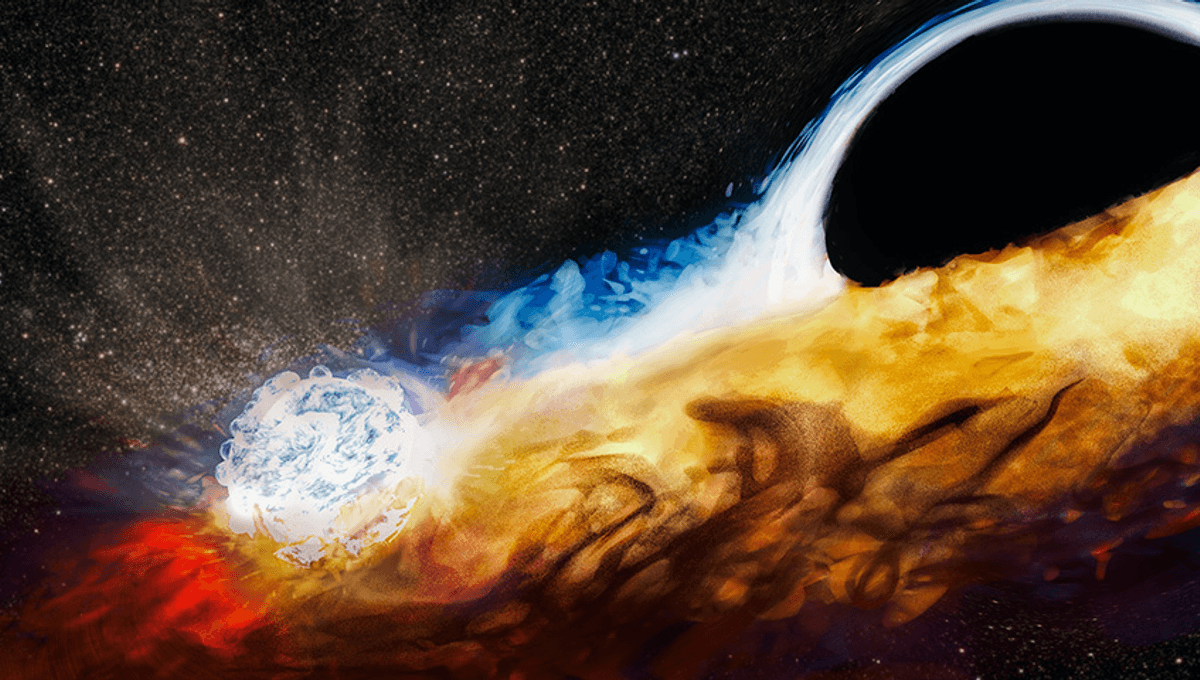
The black hole that was recently spotted consuming a star that got too close has found its next victim, which may be another black hole. Astronomers are looking forward to watching the process in action, and have used what they have already seen to confirm a link between two scientific mysteries.
One of the thrillingly horrifying discoveries physicists have made that outdoes ancient myths is that black holes can “spaghettify” objects, drawing them out into long, thin strands with their gravitational gradient. Supermassive black holes (SMBHs) at the center of galaxies can spaghettify entire stars. Theoreticians worked out that this was what would happen long before we saw it in action, so it was quite exciting when our best view yet of such an event was reported.
At 215 million light-years away, AT2019qi (a “z” has since been added) does not exactly present a ring-side view. Nevertheless, it’s close enough that we were able to see a bright flash as half a star, similar in mass to our Sun, got stretched out into a long strand as the rest was swallowed by the black hole. This made it the closest optical evidence of what is known as a tidal disruption event (TDE), more often seen in X-rays.
Analysis of the nature of the light led to the conclusion that part of the former star had become a spherical cloud driven by mighty winds from the black hole.
The debris created by that event has turned out to be highly significant for another object orbiting the SMBH at what had previously been a (temporarily) safe distance. We can’t see the orbiting object directly, so we don’t know if it is a star or a smaller black hole. We do know that it is crashing through the debris of the previous star approximately once every two Earth days. That passage releases X-ray bursts that have been observed by the Chandra space telescope and the Neutron Star Interior Composition Explorer (NICER).
“Imagine a diver repeatedly going into a pool and creating a splash every time she enters the water,” said Dr Matt Nicholl of Queen’s University Belfast in a statement. “The star in this comparison is like the diver and the disk is the pool, and each time the star strikes the surface it creates a huge ‘splash’ of gas and X-rays. As the star orbits around the black hole, it does this over and over again.”
Between the X-ray telescopes, nine flashes have been observed.
Astronomers have observed X-ray flashes like this before, which they called quasi-periodic eruptions (QPEs). Prior to this event their cause was still debated, but the SMBH responsible for AT2019qiz is visible enough that Nicholl and colleagues are confident it’s a product of the orbiting object’s passage through the debris from a TDE. This doesn’t prove all QPEs have the same cause, but it’s a big hint, particularly given strong similarities with some other QPEs.
“This is a big breakthrough in our understanding of the origin of these regular eruptions,” said Dr Andrew Mummery of Oxford University. “We now realize we need to wait a few years for the eruptions to ‘turn on’ after a star has been torn apart because it takes some time for the disk to spread out far enough to encounter another star.”
Co-author Dr Dheeraj Pasham of MIT said, “It’s like getting a cosmic two-for-one in terms of solving mysteries.”
The authors estimate that QPEs are about a tenth as common as TDEs. If this is confirmed, it would tell us something about the environments around SMBHs and how often there are stars in the danger zone.
The energy from these flashes must come from somewhere, and that is the orbiter’s gravitational potential energy, which the friction of passage will gradually eat into. This means the star or small black hole will spiral inwards, like a satellite that starts to encounter the sparse outermost parts of the atmosphere.
SMBHs’ have no aversion to cannibalism, so whatever its nature the smaller object will get consumed. If it’s a star, we could see a repetition, where some of it becomes yet another debris disk to ensnare yet more prey. It’s like a cosmic multi-level marketing scheme, and just goes to show that you can’t save yourself from predators by hoping someone else gets eaten first.
The study is published open access in Nature.
Source Link: Nearest Star-Eating Supermassive Black Hole Starts On New Victim